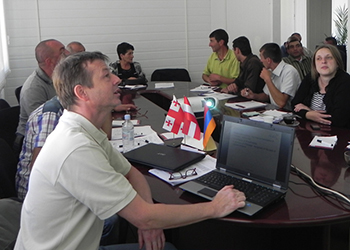Story and Photos by Heifer Georgia

Twenty Georgian and Armenian veterinarians met to learn more about animal health care. The training was part of the Animal Health Care in Cross-Border Areas of Armenia and Georgia project, which was funded by the Austrian Development Cooperation and implemented in Georgia and Armenia by Heifer International.
All the veterinarians had previously participated in training conducted in the Samtskhe-Javakheti and Kvemo Kartli regions in Georgia or the Lori and Shirak regions in Armenia. This training was held in the village of Azatan on September 25-27, 2012.
During the training, lecturers gave a detailed review and discussion of a number of animal diseases, their diagnosis and the newest methods of treatment. Dr. Hubert Weinberger gave interactive lectures. Before the lectures, participants conducted a brief study to determine the diseases that were most interesting to the veterinarians or most problematic in the target regions.The training was held at the newly opened Farmer Service Center. The training also included a practical lesson in necropsy where participants observed and diagnosed domestic animals.

The participants enjoyed the workshop. They said that in addition to providing useful information, the workshop also gave them the opportunity to learn from colleagues from the other side of the border, which will help them in limiting the spread of diseases across the border. The next joint training will be held in 2013 in Georgia.
The Animal Health Care in Cross-Border Areas of Armenia and Georgia project strives to improve economic viability along the Armenian and Georgian border through awareness building about the prevention and control of diseases, improvement of herd management and development of private veterinary businesses. Protecting livestock against diseases and preventing its spread is vital to fighting hunger, poverty and malnutrition.